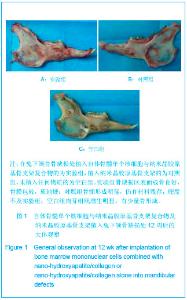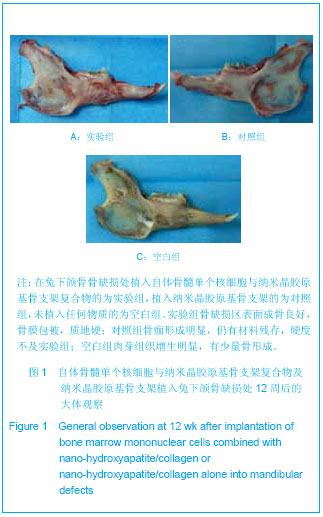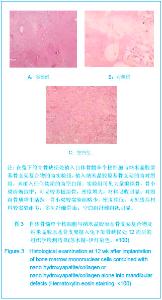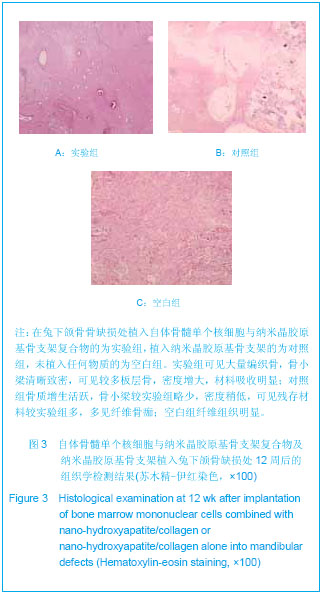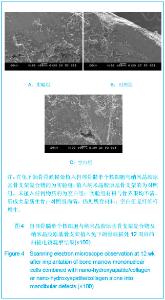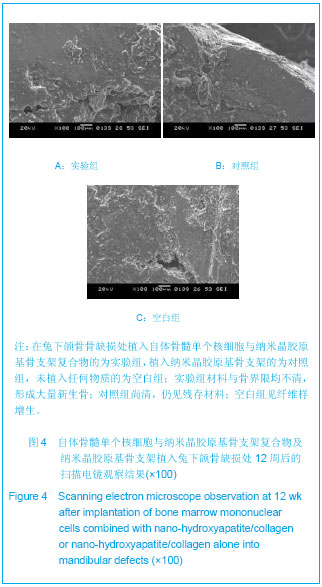Chinese Journal of Tissue Engineering Research
Previous Articles Next Articles
Bone marrow mononuclear cells combined with nano-hydroxyapatite/collagen for repair of mandibular defects
Wu Guang-xin, Wang Jian-guo, Du Xiao-yan
- Department of Oral and Maxillofacial Surgery, Hospital of Stomatology, Jiamusi University, Jiamusi 154000, Heilongjiang Province, China
-
Received:2012-12-18Revised:2013-01-19Online:2013-09-17Published:2013-09-17 -
Contact:Du Xiao-yan, Master, Chief physician, Department of Oral and Maxillofacial Surgery, Hospital of Stomatology, Jiamusi University, Jiamusi 154000, Heilongjiang Province, China dxy00007@163.com -
About author:Wu Guang-xin★, Studying for master’s degree, Department of Oral and Maxillofacial Surgery, Hospital of Stomatology, Jiamusi University, Jiamusi 154000, Heilongjiang Province, China wgx629582@163.com
CLC Number:
Cite this article
Wu Guang-xin, Wang Jian-guo, Du Xiao-yan. Bone marrow mononuclear cells combined with nano-hydroxyapatite/collagen for repair of mandibular defects[J]. Chinese Journal of Tissue Engineering Research, doi: 10.3969/j.issn.2095-4344.2013.38.014.
share this article
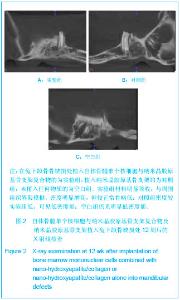
术后4周时,实验组见缺损区材料少量吸收,与周围骨组织融合尚可,质地略硬;对照组材料未见明显吸收,纤维组织充填,与周围边界明显,质地软;空白组见肉芽组织长入,炎性渗出明显。术后8周时,实验组材料小部分吸收,骨痂形成明显,质地较硬;对照组材料少量吸收,形成少量骨痂,残存材料较多,质地较软,硬度不及实验组;空白组肉芽组织增生明显。术后12周时实验组骨缺损区表面成骨良好,骨膜包被,质地硬;对照组骨痂形成明显,仍有材料残存,硬度不及实验组;空白组肉芽组织增生明显,有少量骨形成,见图1。 2.3 各组影像学分析结果 术后4周时,实验组见骨缺损区网状高密度影出现,材料少量吸收,有早期成骨现象,与周围组织界限清;对照组骨缺损成低密度影,有材料阻射影,与周围界限清,无明显成骨;空白组明显低密度影。术后8周时,实验组材料小部分吸收,出现絮状高密度影,成骨较多,密度略高;对照组材料少量吸收,少量成骨,密度较低,与周围组织界限尚清;空白组明显低密度影,术后12周时,实验组材料明显吸收,与周围组织界限模糊,密度明显增高,但较正常骨略低;对照组密度较实验组低,可见低密度影;空白组仍见明显低密度影,见图2。"
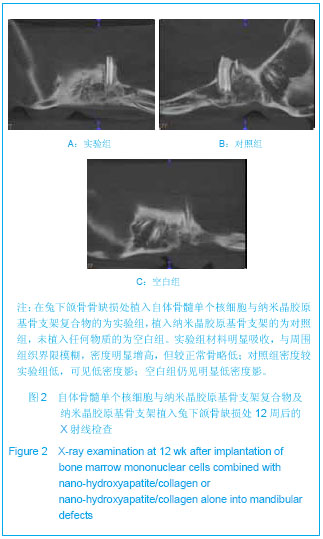
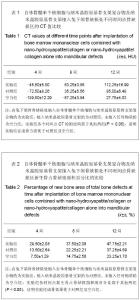
2.6 各组骨缺损区CT值测定比较分析结果 术后4,8,12周牙CT扫描骨缺损区内6个不同位点,记录CT值并取均值后进行统计分析:实验组成骨CT值高于对照组和空白组(P < 0.05),说明实验组在成骨方面优于对照组及空白组,见表1。 2.7 各组骨缺损区新生骨占骨缺损面积的百分比比较分析结果 将术后4,8,12周3个时间段所有组织连续切片,进行系统选片,每块组织选5张,光镜100倍下每张切片系统随机选取8个视野,在图像分析仪下进行组织学形态分析,测定术后各个时间点上新生骨小梁面积所占修复区面积的比值。发现实验组新生骨小梁面积占修复区面积的比值高于对照租及空白组(P < 0.05),证明实验组成骨效果优于对照组及空白组,见表2。"
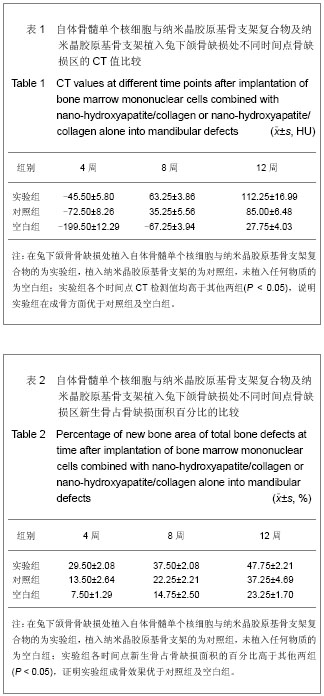
| [1] 孙伟,李子荣,史振才,等.骨髓间充质干细胞对股骨头坏死缺损模型修复的组织学观察[J].中国康复理论与实践,2005,11(1):4-6. [2] Solchaga LA,Zale EA. Prostaglandin E2: a putative potency indicator of the immunosuppressive activity of humanmesenchymal stem cells.Am J Stem Cells. 2012; 1(2): 138-145. [3] Gu Q,Cai Y,Huang C,et al.Curcumin increases rat mesenchymal stem cell osteoblast differentiation but inhibits adipocyte differentiation.Pharmacogn Mag.2012;8(31): 202-208. [4] Santander S,Alcaine C,Lyahyai J,et al. In vitro osteoinduction of human mesenchymal stem cells in biomimetic surface modified titanium alloy implants.Dent Mater J. 2012;31(5): 843-350. [5] Heeger CH,Jaquet K,Thiele H,et al.Percutaneous, transendocardial injection of bone marrow-derived mononuclear cells in heart failure patients following acute ST-elevation myocardial infarction: ALSTER-Stem Cell trial.EuroIntervention. 2012;8(6):732-742. [6] Prasad K,Mohanty S,Bhatia R,et al.Autologous intravenous bone marrow mononuclear cell therapy for patients with subacute ischaemic stroke: A pilot study.Indian J Med Res. 2012;136(2):221-228. [7] Dumas A,Moreau MF,Ghérardi RK,et al.Bone grafts cultured with bone marrow stromal cells for the repair of critical bone defects: An experimental study in mice. J Biomed Mater Res A. 2009;90(4):1218-1229. [8] Yamasaki T,Yasunaga Y,Ishikawa M,et al. Bone-marrow-derived mononuclear cells with a porous hydroxyapatite scaffold for the treatment of osteonecrosis of the femoral head: a preliminary study.J Bone Joint Surg Br.2010;92(3):337-341. [9] Karatoprak O,Korkmaz MF,Kara AN,et al. Early results of autologous mononuclear bone marrow cell implantation in nontraumatic avascular necrosis of the femoral head.Acta Orthop Traumatol Turc.2008;42(3):178-183. [10] Wang BL,Sun W,Shi ZC,et al.Treatment of nontraumatic osteonecrosis of the femoral head with the implantation of core decompression and concentrated autologous bone marrow containing mononuclear cells.Arch Orthop Trauma Surg.2010;130(7):859-865. [11] Sun Y,Feng Y,Zhang C.The effect of bone marrow mononuclear cells on vascularization and bone regeneration in steroid-induced osteonecrosis of the femoral head.Joint Bone Spine.2009;76(6):685-690. [12] Sen RK,Tripathy SK,Aggarwal S,et al. Early results of core decompression and autologous bone marrow mononuclear cells instillation in femoral head osteonecrosis: a randomized control study.J Arthroplasty. 2012;27(5):679-686. [13] Brenneman M,Sharma S,Harting M,et al.Autologous bone marrow mononuclear cells enhance recovery after acute ischemic stroke in young and middle-aged rats.J Cereb Blood Flow Metab. 2010;30(1):140-149. [14] Kamiya N,Ueda M,Igarashi H,et al.Intra-arterial transplantation of bone marrow mononuclear cells immediately after reperfusion decreases brain injury after focal ischemia in rats. Life Sci.2008;83(11-12):433-437. [15] Giraldi-Guimarães A,Rezende-Lima M,Bruno FP,et al. Treatment with bone marrow mononuclear cells induces functional recovery and decreases neurodegeneration after sensorimotor cortical ischemia in rats. Brain Res. 2009;1256: 108-120. [16] Traverse JH,Henry TD,Moye' LA.Is the measurement of left ventricular ejection fraction the proper end point for cell therapy trials? An analysis of the effect of bone marrow mononuclear stem cell administration on left ventricular ejection fraction after ST-segment elevation myocardial infarction when evaluated by cardiac magnetic resonance imaging.Am Heart J. 2011;162(4):671-677. [17] Pokushalov E,Romanov A,Chernyavsky A,et al.Efficiency of intramyocardial injections of autologous bone marrow mononuclear cells in patients with ischemic heart failure: a randomized study.J Cardiovasc Transl Res. 2010;3(2): 160-168. [18] Moniche F,Gonzalez A,Gonzalez-Marcos JR,et al.Intra-arterial bone marrow mononuclear cells in ischemic stroke: a pilot clinical trial.Stroke. 2012;43(8):2242-2244. [19] 廖福琴,张洁,吴燕丽,等.胶原基纳米骨修复拔牙创及颌骨囊肿术后骨腔的疗效观察[J].中国骨质疏松杂志,2004,10(3):316-329. [20] 张丽军,王影,吴燕丽,等.胶原基纳米骨修复兔下领骨缺损的实验研究[J].中国骨质疏松杂志,2004,10(2):155-157. [21] 沈铁城,黄永辉,徐晓峰,等.纳米晶胶原基骨材料在临床上的应用[J].医学研究杂志,2006,35(4):70-73. [22] Liu X,Liu HY,Lian X,et al.Osteogenesis of mineralized collagen bone graft modified by PLA and calcium sulfate hemihydrate: In vivo study. J Biomater Appl. 2013;28(1): 12-19. [23] Wu DJ,Hao AH,Zhang C,et al.Promoting of angiogenesis and osteogenesis in radial critical bone defect regions of rabbits withnano-hydroxyapatite/collagen/PLA scaffolds plus endothelial progenitor cells.Zhonghua Yi Xue Za Zhi. 2012; 92(23):1630-1634. |
| [1] | Shen Jinbo, Zhang Lin. Micro-injury of the Achilles tendon caused by acute exhaustive exercise in rats: ultrastructural changes and mechanism [J]. Chinese Journal of Tissue Engineering Research, 2021, 25(8): 1190-1195. |
| [2] | Liang Xueqi, Guo Lijiao, Chen Hejie, Wu Jie, Sun Yaqi, Xing Zhikun, Zou Hailiang, Chen Xueling, Wu Xiangwei. Alveolar echinococcosis protoscolices inhibits the differentiation of bone marrow mesenchymal stem cells into fibroblasts [J]. Chinese Journal of Tissue Engineering Research, 2021, 25(7): 996-1001. |
| [3] | Duan Liyun, Cao Xiaocang. Human placenta mesenchymal stem cells-derived extracellular vesicles regulate collagen deposition in intestinal mucosa of mice with colitis [J]. Chinese Journal of Tissue Engineering Research, 2021, 25(7): 1026-1031. |
| [4] | Liu Liu, Zhou Qingzhu, Gong Zhuo, Liu Boyan, Yang Bin, Zhao Xian. Characteristics and manufacturing techniques of collagen/inorganic materials for constructing tissue-engineered bone [J]. Chinese Journal of Tissue Engineering Research, 2021, 25(4): 607-613. |
| [5] | Xu Xiaoming, Chen Yan, Song Qian, Yuan Lu, Gu Jiaming, Zhang Lijuan, Geng Jie, Dong Jian. Human placenta derived mesenchymal stem cell gel promotes the healing of radiation skin damage in SD rats [J]. Chinese Journal of Tissue Engineering Research, 2021, 25(25): 3976-3980. |
| [6] | Wang Hao, Chen Mingxue, Li Junkang, Luo Xujiang, Peng Liqing, Li Huo, Huang Bo, Tian Guangzhao, Liu Shuyun, Sui Xiang, Huang Jingxiang, Guo Quanyi, Lu Xiaobo. Decellularized porcine skin matrix for tissue-engineered meniscus scaffold [J]. Chinese Journal of Tissue Engineering Research, 2021, 25(22): 3473-3478. |
| [7] | Chen Lei, Zheng Rui, Jie Yongsheng, Qi Hui, Sun Lei, Shu Xiong. In vitro evaluation of adipose-derived stromal vascular fraction combined with osteochondral integrated scaffold [J]. Chinese Journal of Tissue Engineering Research, 2021, 25(22): 3487-3492. |
| [8] | Chen Song, He Yuanli, Xie Wenjia, Zhong Linna, Wang Jian. Advantages of calcium phosphate nanoparticles for drug delivery in bone tissue engineering research and application [J]. Chinese Journal of Tissue Engineering Research, 2021, 25(22): 3565-3570. |
| [9] | Yang Li, Li Xueli, Song Jinghui, Yu Huiqian, Wang Weixia. Effect of cryptotanshinone on hypertrophic scar of rabbit ear and its related mechanism [J]. Chinese Journal of Tissue Engineering Research, 2021, 25(20): 3150-3155. |
| [10] | Liu Zhendong, Wang Rui, Li Xiaolei, Wang Jingcheng. Review of interferon alpha-2b inhibiting scar formation [J]. Chinese Journal of Tissue Engineering Research, 2021, 25(2): 317-321. |
| [11] | Chen Siyu, Li Yannan, Xie Liying, Liu Siqi, Fan Yurong, Fang Changxing, Zhang Xin, Quan Jiayu, Zuo Lin. Thermosensitive chitosan-collagen composite hydrogel loaded with basic fibroblast growth factor retards ventricular remodeling after myocardial infarction in mice [J]. Chinese Journal of Tissue Engineering Research, 2021, 25(16): 2472-2478. |
| [12] | Chen Liang, Meng Shu, Cheng Guoping, Ding Yi . Effects of fish scale collagen membrane on adhesion, proliferation and osteogenic differentiation of rat bone marrow mesenchymal stem cells [J]. Chinese Journal of Tissue Engineering Research, 2021, 25(16): 2494-2499. |
| [13] | Zhang Hui, Wang Shaohua, Wang Qian, Wang Hui, Gan Hongquan, Cui Yishuang, Li Qijia, Wang Zhiqiang. Porous tantalum coated with RGD polypeptide can activate the integrin/focal adhesion kinase signaling pathway of MG63 cells [J]. Chinese Journal of Tissue Engineering Research, 2021, 25(16): 2535-2540. |
| [14] | Li Shao, Liang Yongkang, Gao Yi, Peng Qing. Establishment and functional in vitro characteristics of three-dimensional collagen HepaRG microsphere [J]. Chinese Journal of Tissue Engineering Research, 2021, 25(16): 2541-2547. |
| [15] | Gan Zhoujie, Pei Xibo. Enzyme-responsive nanoparticles in tumor therapy: superiority of nanoparticles in accumulation and drug release [J]. Chinese Journal of Tissue Engineering Research, 2021, 25(16): 2562-2568. |
| Viewed | ||||||
|
Full text |
|
|||||
|
Abstract |
|
|||||
